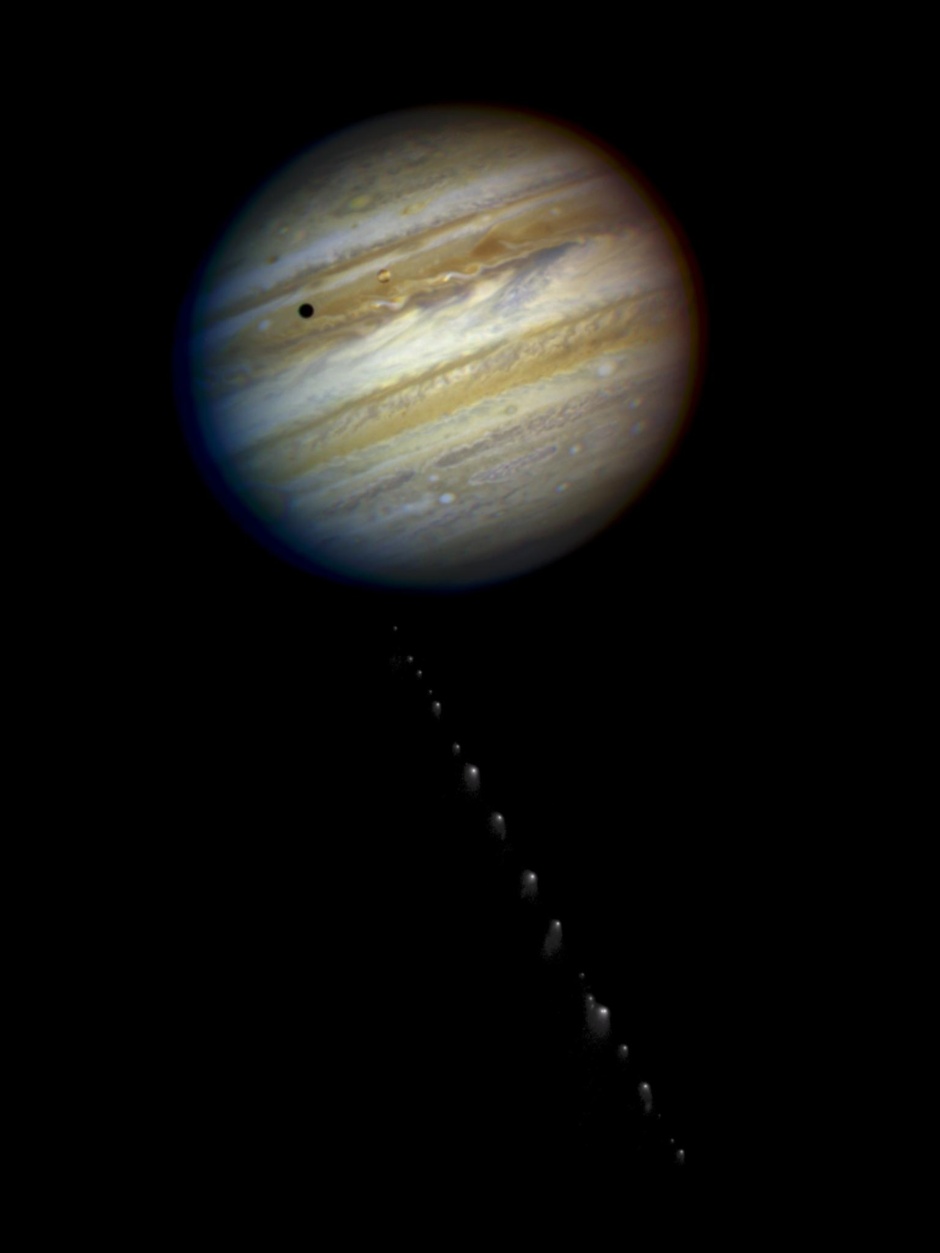혜성의 행성 충돌과 그 위력을 관측하다.
이 이미지는 목성의 이미지에 허블의 광대역행성형카메라2(WFPC-2)로 촬영한 슈메이커 레비 9 혜성의 이미지를 합성한 것이다.
목성은 1994년 5월 18일에 지구로부터 6억 7천만 킬로미터 지점에 있을 때 촬영된 것으로 색채는 허블 망원경의 삼원색(적색, 푸른색, 녹색) 노출로 촬영한 이미지를 합성하여 만들어낸 것이다.
목성의 자전 때문에 목성 양쪽 주위에 푸른 색과 붉은 색의 번짐현상이 나타나 있다.
허블 우주 망원경은 광대역 모드를 활용하여 목성의 거대한 구름 벨트를 폭 320킬로미터까지 식별가능한 해상도로 촬영하였다.
이처럼 정밀한 사진은 목성을 향해 항해를 했던 우주선 외에는 얻을 수 없는 사진이었다.
목성에 검은 점으로 찍혀 있는 것은 목성의 위성인 '이오'의 그림자이다.
이 그림자의 상단 우측으로 오렌지색과 노란색으로 섞인 화산으로 가득한 위성 '이오'가 보인다.
비록 '이오'의 크기는 달 정도 크기(그러나 거리로는 2000배나 떨어져 있다.)에 지나지 않지만 허블 망원경은 그 표면을 상세하게 담아낼 수 있다.
슈메이커 레비 혜성이 5월 17일 관찰됐을 때, 우주 상에 110만 킬로미터에 걸쳐(이것은 지구와 달사이 거리의 3배에 달한다.) 21개의 얼음 조각들이 길게 늘어서 있었다.
그래서 길게 늘어선 모든 혜성의 핵들을 담아내기 위해 6개의 WFPC가 동원되었다.
혜성의 사진은 적색노출로 촬영되었다.
목성과 혜성의 상대적인 크기는 삽화로 사용될 목적으로 편집된 것이다.
지구의 모든 핵폭탄이 일시에 폭발한다고 상상해 보라.
그리고 이러한 대폭발이 일주일에 무려 스무번이 넘게 반복된다고 상상해 보라.
그정도의 폭발이면 지구의 모든 지각이 파괴되었을테지만, 실제로 1994년 이와 같은 재앙이 목성에 일어났을 때 목성은 거의 꿈쩍도 하지 않았다.
허블은 스무개 남짓한 혜성의 핵들이 목성으로 돌진하는 세기의 이벤트가 발생할 때 이 모든 광경을 생생하게 볼 수 있게 도와주었다.
허블을 통해 목성의 하늘로 거대한 버섯모양의 불기둥이 치솟는 드라마틱한 모습을 포착할 수 있었던 것이다.
슈메이커 레비 9라고 명명되었던 이 혜성은 2년 전 목성의 중력에 포섭되면서 여러조각으로 갈라졌다.
이들의 충돌은 목성의 구름에 일시적인 검은색 상처를 남겼다.
* '허블사이트'의 게시물들은 허블사이트 http://hubblesite.org 의 뉴스센터 자료들을 번역한 자료들입니다
참고 : 목성과 목성의 달에 대한 각종 포스팅은 아래 링크를 통해 조회할 수 있습니다.
https://big-crunch.tistory.com/12346946
참고 : 슈메이커 레비 혜성을 비롯한 태양계의 다양한 작은 천체에 대한 포스팅은 아래 링크를 통해 조회할 수 있습니다.
왜소행성 : https://big-crunch.tistory.com/12346957
소행성 : https://big-crunch.tistory.com/12346956
혜성 : https://big-crunch.tistory.com/12346955
유성 : https://big-crunch.tistory.com/12346954
원문>
ABOUT THIS IMAGE:
This is a composite photo, assembled from separate images of Jupiter and Comet P/Shoemaker-Levy 9, as imaged by the Wide Field & Planetary Camera-2 (WFPC-2), aboard. NASA's Hubble Space Telescope (HST).
Jupiter was imaged on May 18, 1 994, when the giant planet was at a distance of 420 million miles (670 million km) from Earth. This "true-color" picture was assembled from separate HST exposures in red, blue, and green light. Jupiter's rotation between exposures creates the blue and red fringe on either side of the disk. HST can resolve details in Jupiter's magnificent cloud belts and zones as small as 200 miles (320 km) across (wide field mode). This detailed view is only surpassed by images from spacecraft that have traveled to Jupiter.
The dark spot on the disk of Jupiter is the shadow of the inner moon lo. This volcanic moon appears as an orange and yellow disk just to the upper right of the shadow. Though lo is approximately the size of Earth's Moon (but 2,000 times farther away), HST can resolve surface details.
When the comet was observed on May 17, its train of 21 icy fragments stretched across 710 thousand miles (1.1 million km) of space, or 3 times the distance between Earth and the Moon This required six WFPC exposures along the comet train to include all the nuclei. The image was taken in red light.
The apparent angular size of Jupiter relative to the comet, and its angular separation from the comet when the images were taken, have been modified for illustration purposes.
Object Names: Jupiter, Comet P/Shoemaker-Levy 9
Imagine setting off every atomic bomb on Earth all at once. Now imagine repeating such an apocalyptic explosion two dozen times in a week! Unleashing such energy would destroy Earth's surface, but the giant planet Jupiter hardly flinched when it underwent such a catastrophe in 1994. Hubble provided a ringside seat to a once-in-a-millennium event when two dozen chunks of a comet smashed into Jupiter.
The telescope snapped dramatic images of massive explosions that sent towering mushroom-shaped fireballs of hot gas into the Jovian sky. The doomed comet, called Shoemaker-Levy 9, had been pulled apart two years earlier by Jupiter's gravity. Each impact left temporary black, sooty scars in Jupiter's planetary clouds.
'3. 천문뉴스 > 허블사이트' 카테고리의 다른 글
| NGC 1672 (0) | 2007.11.27 |
|---|---|
| 허블망원경을 통해 이룩한 과학적 발견 -12- (0) | 2007.11.24 |
| 허블망원경을 통해 이룩한 과학적 발견 -10- (0) | 2007.11.20 |
| 허블망원경을 통해 이룩한 과학적 발견 -9- (0) | 2007.11.20 |
| 허블망원경을 통해 이룩한 과학적 발견 -8- (0) | 2007.11.18 |
